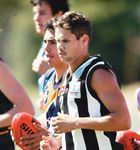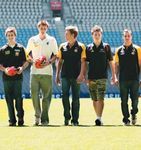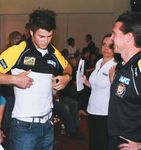AFL RISING STARS PROGRAM - AFL Community
←
→
Page content transcription
If your browser does not render page correctly, please read the page content below
A F L R I S I N G S TA R S P R O G R A M
AFL Rising Stars Program
13 -18 years
The AFL talent identification and development program AIS-AFL Academy
is formalised in the NAB AFL Rising Stars Program. The The AIS-AFL Academy is a joint program of the
development program operates from grass roots through Australian Sports Commission, the Australian Institute
to the elite AFL level. It provides recognition and of Sport (AIS) and the AFL to enhance the sporting,
a clearly identifiable direction for a player’s career. personal, educational and vocational opportunities for
The program incorporates the: Australia’s best young footballers.
Each year the AIS-AFL Academy offers 30 12-month
NAB AFL Rising Star; scholarships to young athletes eligible to represent their
NAB AFL Draft; state or territory at the NAB AFL Under-16 Championships
NAB AFL Draft Camp; but ineligible for the draft in that year.
AIS-AFL Academy;
NAB AFL Under-18 Championships; and Scholarship holders remain in their home states but
NAB AFL Under-16 Championships. gather together for 3 national camps and other training
programs during the year. Squad members are also
NAB AFL Draft given the opportunity to represent Australia at under-17
The NAB AFL Draft is the only process through which level in the International Rules Series against Ireland or
a footballer can become an AFL player. It is the most on a tour of South Africa.
equitable way of distributing the available talent to AFL
clubs. Players gain access to clubs by nominating for NAB AFL Draft Camp
the draft and can only move to other clubs through the The NAB AFL Draft Camp has become an integral
draft process. The draft is critical to the AFL’s objective of part of the talent identification process for AFL clubs.
developing an even competition because: The process has been refined and improved and the
AFL invites about 70 players to the annual camp at the
it gives the lesser-performed clubs in a season first AIS in Canberra and a further 100-plus prospects to
choice of the available players; shorter testing programs in their home states.
it gives clubs the option of exchanging draft choices,
players or a combination of both; and Information is the AFL club recruiting managers’ greatest
uncontracted players can change clubs by nominating tool and insights gained through the draft camp and
for the NAB AFL Pre-season Draft. the AFL recruiting reports is invaluable to clubs as they
consider which players to draft. Key elements of the
Clubs can also maintain a rookie list of up to 6 draft camp include medical screening, physical and
developing players between 18-23, although these psychomotor testing, formal and informal interviews with
players are not eligible to play in the AFL premiership AFL clubs and skills sessions.
competition except as an injury replacement. A separate
Rookie Draft is conducted for this purpose. The following Players are organised into 7 positional groups for camp
components of the NAB AFL Rising Stars Program lead operations and testing – small midfielders, medium
directly to the Draft. midfielders, medium forwards, medium defenders, tall
forwards, tall defenders and ruckmen.
NAB AFL U16 & U18 Championships
The NAB AFL Under-16 and Under-18 Championships Some of the test protocols used for the draft camp, including
are played annually between state and territory speed, agility, vertical jumps and endurance tests can be
teams in 2 divisions, incorporating teams from South found in the AFL Youth Coaching Manual. Coaches who
Australia, Western Australia, Victorian Country, Victorian wish to use formal testing with their youth players can obtain
13 - 18 Y E A R S
Metropolitan, New South Wales/ACT, Northern Territory, further information from AFL regional development offices.
Queensland and Tasmania.
50 NEXT GENERATION AUSTRALIAN FOOTBALL MATCH POLICYA F L R I S I N G S TA R S P R O G R A M
Talent development structures
The talent development structure is being further developed to ensure the transfer of the philosophy and curriculum of the
AIS-AFL Academy through AFL state academies, AFL centres of excellence and AFL sports schools.
The curriculum is delivered through the following structures:
LEVELS/STAGE NO. OF CONTACT
& PROVIDER PARTICIPANTS HOURS PER
YEAR
L3 AFL clubs L3 350 1200
STAGE 6 MAINTENANCE
L2 State league clubs L2 2000 240
23-30+ YRS STAGE
L1 Community clubs L1 40,000 160
L3 AFL clubs L3 350 1200
STAGE 5 INVESTMENT
L2 State league clubs L2 4000 240
19-22 YRS STAGE
L1 Community clubs L1 40,000 160
L3 AIS-AFL Academy L3 30 325
STAGE 4 SPECIALISING L2 AFL state academy L2 320 200
17-18 YRS STAGE L1 AFL centre of excellence and state L1 2400 240
league clubs
L3 AFL state academy L3 320 100
STAGE 3 IDENTIFICATION L2 AFL centre of excellence and state L2 2400 240
15-16 YRS STAGE league clubs L1 25,000 100
L1 AFL sports school & reg dev squads
L3 AFL Lions/Swans academies L3 200 40
STAGE 2 SAMPLING
L2 Rep league programs L2 2000 40
12-14 YRS STAGE
L1 AFL Youth club & school competitions L1 80,000 180
STAGE 1 FUNDAMENTAL L1 AFL Auskick/AFL Junior club &
L1 306,000 180
5-11 YRS STAGE school competitions
13 - 18 Y E A R S
52 NEXT GENERATION AUSTRALIAN FOOTBALL MATCH POLICYA F L R I S I N G S TA R S P R O G R A M
Minimum standards will apply within each level
AIS- AFL Academy Squad AFL State Academies AFL Centres of Excellence
Participants Participants Participants
30 AIS scholarship holders Up to 40 per age level in each state 4800 players participating in elite
for a total of 640 players nationally state league competitions
(under-16 and under-18)
Staffing
Staffing
Level 3 coaches Staffing
Level 2 coaches
AFL-standard service providers Level 3 coaches
Accredited support staff
Adherence to AFL philosophies, State-league-standard service
practices and code of conduct providers Adherence to AFL philosophies,
practices and code of conduct
Adherence to AFL philosophies,
practices and code of conduct
Facilities
Facilities
AFL-standard playing and
training facilities Facilities State level playing and training
facilities
State-level playing and training
facilities IT (Champion Data) standard
Curriculum practices
IT (Champion Data) standard
325 hours contact time practices
Best-practice curriculum Curriculum
Documented game plan and Curriculum Contact time not less than 240 hours
team rules Documented game plan and
Minimum face-to-face contact hours,
Personal development plans for 200 at the under-18 level and 100 at team rules
all participants the under-16 level Development plans for all
Delivered using AFL-standard IT Documented game plan and participants
practices including video and other team rules Adherence to nationally established
performance analysis techniques development curriculum
Personal development plans for
all participants Delivered using cutting-edge
Adherence to nationally established educational and IT practices
Competition
development curriculum
International tour Delivered using cutting-edge
educational and IT practices Competition
Participation in state league
competition
Competition
State academy match program is the
NAB AFL Under-16 and Under-18
13 - 18 Y E A R S
National Championships
NEXT GENERATION AUSTRALIAN FOOTBALL MATCH POLICY 53A F L R I S I N G S TA R S P R O G R A M
The curriculum will have 6 core components
Physical Skill Nutrition & Personal Athlete & AFL Policy
Preparation Development Recovery Development Career
Education
Medical General Psychological ASADA-AFL
Learning style Computer skills
screening education profiling policy
Kicking Mental Individualised Respect &
Fitness testing Food diaries
technique toughness assessments responsibility
Running Individualised Stress Monitoring Race & religious
Conditioning
technique reviews & minimisation performance vilification
food plans
Drafting & the
Profiling Game sense Losing/gaining Goal-setting Study skills
AFL pathway
weight
Game Positive Time
Prioritising
knowledge Hydration self-image management
Program Personal Educational
Game balance Recovery
assessment growth/life skills support
practices
Heat & training Decision-making Practical Public speaking Welfare issues
sessions
Reading your Team rules/
Media training
body game plan Drugs & alcohol
AFL player
Immunisation Etiquette
profiling
Basics of the
Leadership
game
Competition
Drugs & alcohol
performance
Performance
Travel
analysis
Enhancing the identification, Enhance the NAB AFL
attraction and development of talent Under-16 Championships
Major improvements to generate better talent Series extended by 3 days to allow for one cross-over
outcomes include: match for Division 1 states to play against Division 2
states and for every participant to be screened.
AFL to take more direct role in monitoring/managing Finals for Divisions 1 and 2 played on AFL Grand Final Day.
second-tier issues:
the objective now specifically encompasses state Enhance the NAB AFL
leagues: “to develop the talented player pathway and Under-18 Championships
enhance second-tier competitions to capture and develop Division 2 becomes a qualifying series to be played
talented players.” separately in May.
13 - 18 Y E A R S
The top-two finishers qualify to enter the Division 1 draw
Transfer the philosophy/curriculum of the AIS-AFL that follows later in the year.
Academy through a structure of: Division 1 becomes a 6-team, 5-match championship.
AFL state academies (e.g. AFL Tasmania Academy);
AFL centres of excellence (pilot 2008);
AFL sports schools (pilot 2009).
54 NEXT GENERATION AUSTRALIAN FOOTBALL MATCH POLICYYou can also read



























































